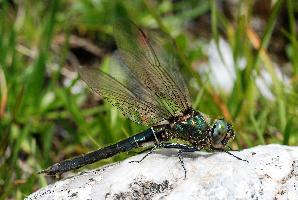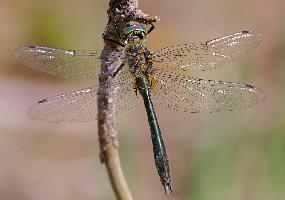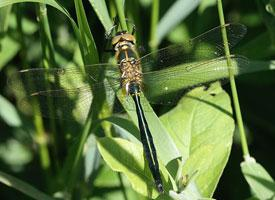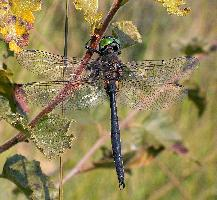
Váhy a míry
| Délka | od 32 do 35 mm |
|---|---|
| Délka rozpětí křídel | od 63 do 72 mm |
Popis zvířete
The Alpine Emerald (Somatochlora alpestris) is a captivating species of dragonfly belonging to the family Corduliidae, often found in the cooler, high-altitude environments of Europe, including parts of the Alps and the Scandinavian mountain range. This species is distinguished by its remarkable adaptability to alpine and subalpine habitats, thriving in areas where few other dragonflies dare to venture.Characterized by its slender body and metallic sheen, the Alpine Emerald exhibits a striking appearance. Adults typically display a brilliant emerald green coloration on their thorax and abdomen, which shimmers under the sunlight, creating a dazzling effect. The wings are transparent, with a span that can reach up to 70 millimeters, allowing for adept flight capabilities. The edges of the wings may have a slight amber tint, adding to the dragonfly's allure. The male and female of the species can be differentiated by subtle variations in their size and the shape of their terminal appendages.
The Alpine Emerald's life cycle is fascinating and somewhat enigmatic, owing to its preference for cold, clear mountain streams and ponds for breeding. The larvae, known as nymphs, are aquatic and predacious, blending seamlessly with the underwater environment where they hunt small invertebrates. This stage of their life can last several years, during which they undergo multiple molts, gradually growing in size and complexity. The nymphs are specially adapted to the cold, oxygen-rich waters of their habitat, showcasing the species' remarkable resilience.
Upon reaching maturity, the nymphs undergo a final molt, emerging from the water as winged adults. This transformation is a critical period in their life cycle, as they are vulnerable to predation. However, once their wings dry and they take to the air, they become agile flyers. Adults feed on flying insects, which they catch in mid-air with remarkable precision. The flight season of the Alpine Emerald is relatively short, typically occurring from late June to August, during which mating and egg-laying take place.
The mating ritual of the Alpine Emerald is a sight to behold, involving intricate aerial displays. After mating, the female lays her eggs in the vegetation near or on the water surface, ensuring the next generation's survival. The eggs hatch into nymphs, and the cycle begins anew.
Conservation of the Alpine Emerald and its habitat is of paramount importance. The species relies on pristine mountain ecosystems, which are increasingly threatened by climate change, pollution, and habitat destruction. Protecting these areas ensures not only the survival of the Alpine Emerald but also the countless other species that share its habitat.
In summary, the Alpine Emerald (Somatochlora alpestris) is a remarkable dragonfly species, embodying the beauty and resilience of alpine ecosystems. Its life cycle, from the aquatic nymph to the dazzling adult, is a testament to the complexity and interconnectedness of nature. As such, it serves as a symbol of the importance of preserving the natural world for future generations to marvel at and enjoy.
Podobná zvířata
Nové fotografie zvířat
Top 10 zvířat
- Chinese water dragon (Physignathus cocincinus)
- Galápagos tortoise (Geochelone nigra complex)
- Dolphin gull (Leucophaeus scoresbii)
- Japanese macaque (Macaca fuscata)
- Colombian red howler (Alouatta seniculus)
- Sea urchins (Echinoidea)
- Diana monkey (Cercopithecus diana)
- Moustached guenon (Cercopithecus cephus)
- Colossal squid (Mesonychoteuthis hamiltoni)
- Common house mosquito (Culex pipiens)


